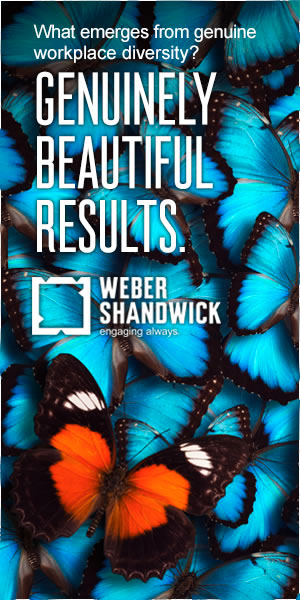Last year at Cannes Lions, MullenLowe launched the 25forty Project, a diversity program to engage the next generation of diverse creative minds.
The initiative seeks 25 agencies to raise their hands to connect with 40 students each with the goal to expose 1,000 creatively-minded, diverse students to careers in advertising each year.
The program began on Jan 1, 2017 and has recruited nearly 20 agencies from various parts of the country, as well as Brazil and Spain, to participate in the program’s first year.
MullenLowe Creative Director, Blake Winfree, and Group Strategy Director, Erin Swenson-Gorrall introduced this project at Cannes and have since been working tirelessly to set up a headquarters team, make connections with agencies and schools across the nation and nurture this passion project.
“Our mission is to galvanize the industry around the issue of diversity in a way that it has never done for anything else before,” explained Blake Winfree and Erin Gorrall, VP, Group Strategy Director. “We realize that what we’ve created is simple at its core but not easy. The practice of inclusion isn’t a passive exercise.”
“This issue requires us to remove ourselves from our offices, go out into our communities and build relationships — real relationships,” they added. “We’ve recruited nearly 20 agencies from various parts of the country, as well as Brazil and Spain, to participate this first year.”
DIVERGE talked to Winfree and Swenson-Gorrall to find out more:
Where did the idea come from?
In the spring of 2016, we were presented with an opportunity to speak at the Cannes Lions International Festival of Creativity regarding the ever-popular topic of diversity in advertising. We’d moderated a diversity panel at SXSW a month earlier, and based on its success, it was proposed that we duplicate the discussion for Cannes. As excited as we were by the opportunity, we felt that these public discourses, though helpful, were primarily passive. The lack of any demonstrable solutions bothered us. So much so that we made a pact of sorts, to create an actionable program that we could launch through the Cannes platform. 25Forty is the result of that opportunity, and from that June day in France to today, we’ve been working to make it real.
Why is diversity so important to your agency?
Diversity is important because inclusion is important. Particularly in advertising. We live in a country that is extremely diverse, and our agencies spend a great deal of time and money trying to understand these eclectic demographics and cultural movements. We increasingly appropriate these cultures on behalf of our clients, yet within our agencies we’re incredibly apathetic to the fact that rarely are the true participants of those cultures at the table shepherding those strategies or creating the work. I don’t know of many areas in life that haven’t benefitted from diversity, especially in the areas of creativity and the arts. Imagine if music or the culinary arts were only crafted by a homogeneous set of hands. Imagine the flavors our palates would never encounter and the sounds our ears would never hear. It’s tragic to think about. I feel similarly about our industry. What ideas and opportunities are we missing by being so exclusionary? I believe deeply that our clients, our work and our bottom lines would benefit greatly from a more inclusionary ad industry.
Why should others make diversity a priority?
When I was in school there was a very hip Asian girl with an incredible sense of style whose upbringing and taste in music, fashion and so forth were very much her own. There wasn’t an individual in our program who shared her life experiences or aesthetic. During the two years I had the pleasure of knowing her, I was acutely attuned to the moments when she shared her latest solution to a design challenge because it was always distinct. It was clear that her approach was motivated by a different set of experiences than my own, and that was reflected in her work. That left a deep impression on me. The idea that a unique set of social circumstances, worldviews and styles could produce such a drastically different body of work than that of the rest of our peers was epiphanous to me. Well over a decade later, I’ve seen this scenario play out many times and believe deeply that the cross-pollination of cultures, ideas and interests is the only way to create an agency ecosystem that truly thrives. Diversity is the lifeblood of any creative institution. Advertising should operate no differently if, indeed, we are the bastions of creativity and culture that we claim to be.
Why is it important to start this initiative at schools and address students?
High school is a time when kids are declaring what and who they want to be. The industries of science, technology and engineering have done a tremendous job acknowledging this talent pool and have designed STEM curriculums aimed at exposing these curious students much earlier. Advertising, by contrast, has done very little to expose and ignite this same talent base — particularly students of color and, more pointedly, those of lesser economic means. In getting to know some of these students we discovered that many of them are creative hand raisers whose interests in music, film and art are just as eclectic and varied as ours. However, the lack of exposure to our industry has created a chasm between them and us, which nullifies advertising as a career option. Making matters worse is that advertising isn’t a field you can easily pivot into once you’ve already chosen another path. There are only a handful of colleges that can properly prepare you for the agency world, particularly if you’re a creative. That makes early exposure that much more critical. Our belief is that if we can garner interest at the high school level, we’ll be able to create a proper pipeline that can turn a student’s interests in advertising into a career in advertising.
How can others help/participate?
For interested agencies, it’s simply a matter of getting in contact with us. There are two ways to participate in the 25Forty project — either through a speaker series or a creative campaign. If an agency chooses the speaker series, the agency will partner with a local high school and, over the course of four to five interactions, introduce its students to the departments and personnel within their agency. Choosing the creative campaign means the agency will partner with a local high school to create an awareness campaign for a local company, service or nonprofit that is adding cultural value to the local community in rich and robust ways. The minimum requirement for the creative campaign is one print asset and one film asset, although the output can be as evolved as the agency and school desires. The work will be judged by a panel of industry professionals, and the top three schools will each receive an award of $10,000. Beyond that, you can participate by simply spreading the word so we can grow the 25Forty project well into the future.
What is your vision for this project in 2017?
In the long term, I think there are many goals, but 2017 is year one and it’s quite honestly a proof-of-concept year. With that said, the one metric that supersedes all others is exposures. We want a diverse collection of kids who have never considered advertising to know it exists and to consider, for the first time in their lives, if it’s a career in which they might see themselves someday. Beyond that, success hinges on the operational things like helping the agencies that have signed on to participate this year to be as successful as they can be (including ourselves). We need to make sure we do everything in our power to apply a megaphone to our efforts from a PR perspective and to lay the foundation for growing this into next year.
Additional thoughts?
We’re eternally grateful to those agencies for taking this leap of faith and we hope their participation helps fuel a movement that grows in both scope and scale in the coming years. We’re fully aware that solving this problem is a long-term endeavor and that the ROI will not be immediate. That’s okay. We’ve all borne witness to the power of creativity and believe that, if deployed with conviction, we will have a sincere impact on these students. Although we won’t convert them all, we believe deeply that we will see many of these talented and diverse artisans again.

